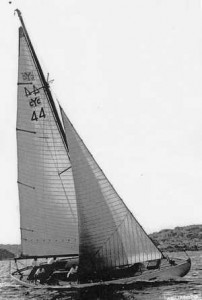- Author
- A.N. Other
- Subjects
- History - general
- Tags
-
- RAN Ships
- None noted.
- Publication
- December 2010 edition of the Naval Historical Review (all rights reserved)
Most of the information for this article came from Dr Marsden Hordern, OAM, who is a long standing member of the Naval Historical Society, an acknowledged author and naval historian. He competed in a number of early Sydney to Hobart races.
For the past sixty and more years on Boxing Day, usually with Sydney Harbour basking in bright sunlight with one hour over the yardarm, a signal gun announces the start of one of the world’s great ocean races. How many now remember the Sydney to Hobart Yacht Race is one of the navy’s unofficial legacies to Australia?
In 1944, with Germany facing defeat, more attention was able to be given to the Pacific region where the Japanese still occupied extensive former territories of the British, French and Dutch. In April that year, the Admiralty sent a naval mission to Australia planning for bases to service one of the mightiest armadas ever assembled in the southern hemisphere to operate against the Japanese. It comprised four battleships, seventeen aircraft carriers, ten cruisers, forty destroyers, thirty one frigates/sloops, thirty eight minesweepers/layers, twenty nine submarines, one hundred escort vessels, twelve hundred aircraft and two amphibious divisions. During the following fifteen months tens of thousands of men flooded into Australia, one of whom was Engineer Captain John Illingworth, RN who was based at Garden Island Dockyard.
In August 1945 with enemy ships and submarines no longer roaming the seas, the oceans returned as a pleasure ground for blue-water yachtsmen. This period of inactivity led to the formation of the Cruising Yacht Club of Sydney, later to become the Cruising Yacht Club of Australia, and some of its new members planned to spend the coming Christmas and New Year on a leisurely cruise to Hobart. Captain Illingworth, an experienced yachtsman, suggested that they make a race of the cruise using a handicap system so that the large fast yachts would rate equally with the small slower ones.

(Image: Cruising Yacht Club of Australia)
Nine yachts started on Boxing Day 1945, of which eight were to complete the race. The winner of line honours and on handicap was Rani, owned and skippered by Captain Illingworth, and in his crew of seven were three other RN officers, Lieut. Cdr. John Hodgson, Lt. Ray Richmond and Lt. Bill Mews, plus Captain Ken Vaughan AIF. The last surviving member of this crew, Ray Richmond, died at his home at Bowral in 2008 aged 88.
Rani, named after the Hindu queen, was a 34 ft 8 in cutter which had been built by local boat builder Les Steel at Speers Point on Lake Macquarie just after the close of WW II. She was the smallest in the inaugural fleet and finished in 6 days 14 hours and 22 minutes. Another entrant, Wayfarer, finished in 11 days 6 hours and 20 minutes which still stands as a race record for the slowest finish.
Radios were not compulsory in those days. Rani had one on loan from an RN carrier but its valves burnt out before the start of the race. When a southerly buster dispersed the fleet all contact was lost and an RAAF Catalina, sent out to search, found them scattered over a wide area but thankfully all were safe.
Shortly after their return from Hobart the Australian Squadron of the Royal Naval Sailing Association was formed, which in 1966 became the RAN Sailing Association (RANSA).
The RNSA yacht Samuel Pepys managed to hitch a ride on a visiting RN carrier and was to race in the 1956 and 1957 Sydney to Hobarts. The peak of naval participation was to be 1956, with three entries: Samuel Pepys, Tam O’Shanter and Four Winds.
One of the early RAN sailors in the race was the young Lt. Marsden Hordem, RANVR who had extensive wartime sea service in Fairmiles in the South West Pacific. When serving at HMAS Platypus in late 1947 a signal arrived from the Cruising Yacht Club seeking officers to help navigate yachts in the next Sydney to Hobart race. Marsden gained a berth as navigator of the 64 ft schooner Mistral where he was to join three others who had seen war service in the RAN: Lt. Cdr. ‘Dickie’ Dillon, Lt. John Betty & PO Jackson Sussman. Mistral had also competed in the inaugural race so she was well attuned to the conditions and finished a creditable second over the line.




